Tourism and Entrepreneurship: A Review of the Literature
VerifiedAdded on 2019/12/28
|14
|4573
|166
Literature Review
AI Summary
Airey et al (2015), Cloutier (2012), Eagles (2014), Hein et al (2013), Jaafar et al (2011), Kimbu and Ngoasong (2013), Li et al (2010), Papatheodorou et al (2010), Pocock and Phua (2011), Rodriguez et al (2014), Sheldon and Dwyer (2010), Steven et al (2013), von der Weppen and Cochrane (2012), Whitelaw et al (2014), Wong et al (2011)
Contribute Materials
Your contribution can guide someone’s learning journey. Share your
documents today.
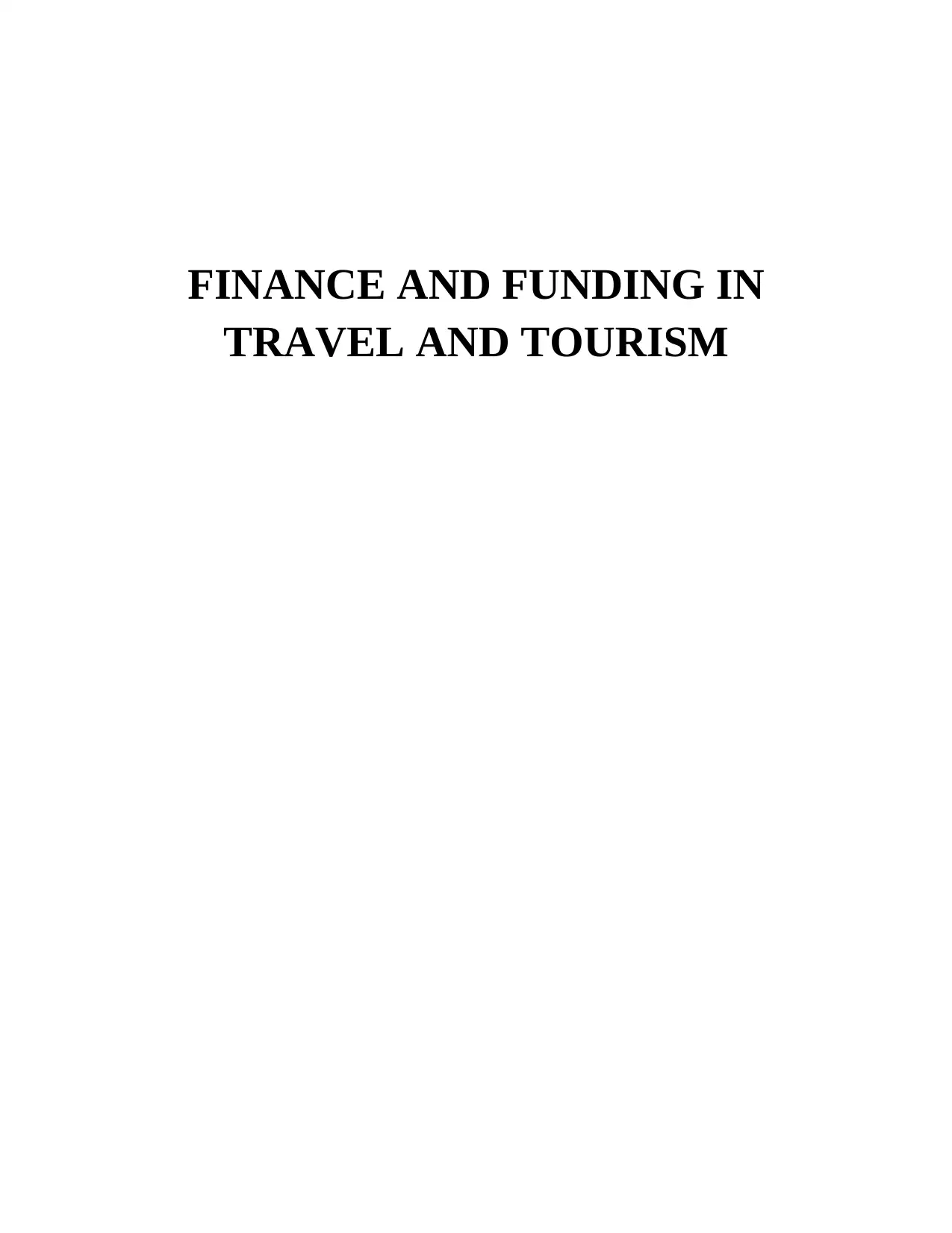
FINANCE AND FUNDING IN
TRAVEL AND TOURISM
TRAVEL AND TOURISM
Secure Best Marks with AI Grader
Need help grading? Try our AI Grader for instant feedback on your assignments.
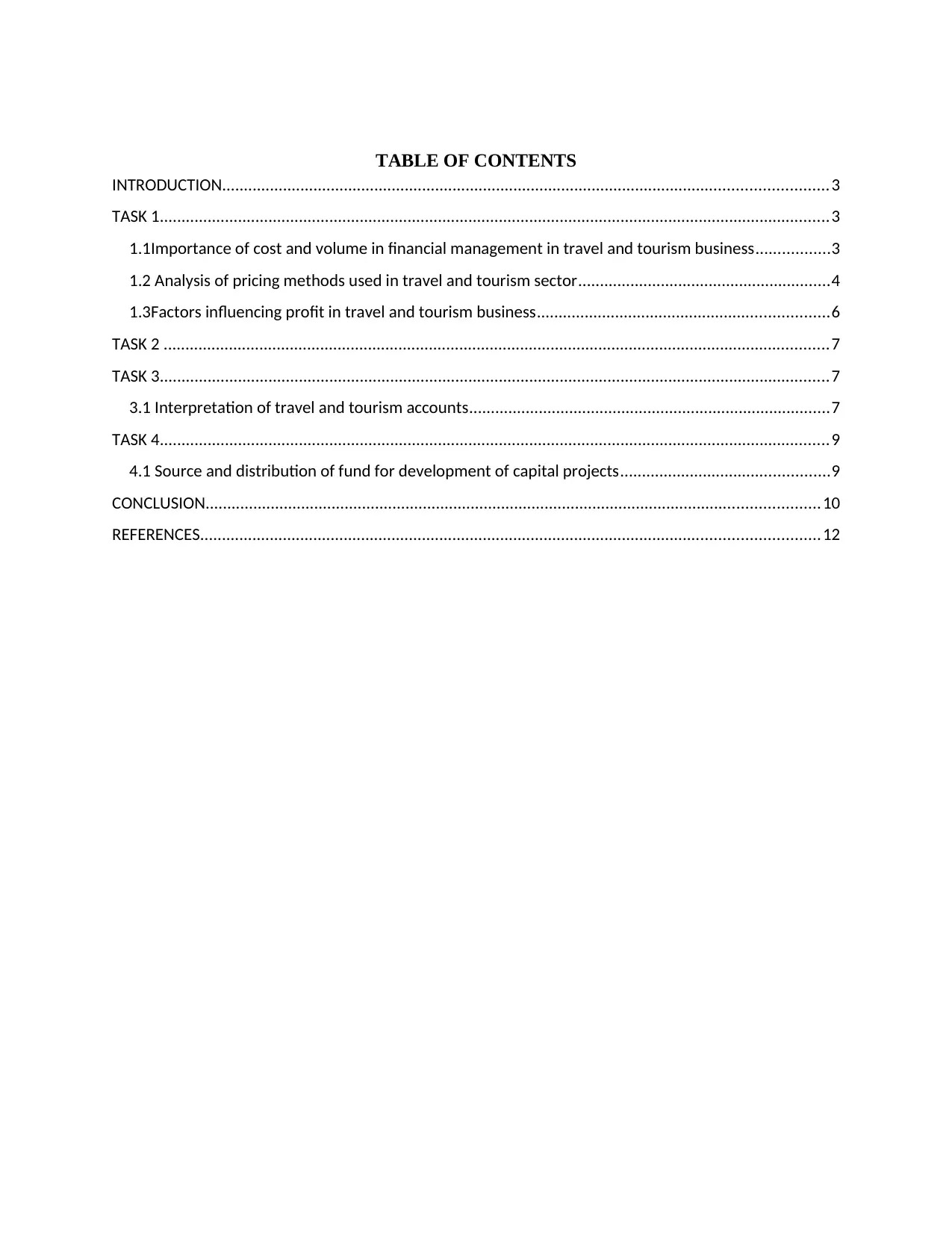
TABLE OF CONTENTS
INTRODUCTION...........................................................................................................................................3
TASK 1..........................................................................................................................................................3
1.1Importance of cost and volume in financial management in travel and tourism business.................3
1.2 Analysis of pricing methods used in travel and tourism sector..........................................................4
1.3Factors influencing profit in travel and tourism business...................................................................6
TASK 2 .........................................................................................................................................................7
TASK 3..........................................................................................................................................................7
3.1 Interpretation of travel and tourism accounts...................................................................................7
TASK 4..........................................................................................................................................................9
4.1 Source and distribution of fund for development of capital projects................................................9
CONCLUSION.............................................................................................................................................10
REFERENCES..............................................................................................................................................12
INTRODUCTION...........................................................................................................................................3
TASK 1..........................................................................................................................................................3
1.1Importance of cost and volume in financial management in travel and tourism business.................3
1.2 Analysis of pricing methods used in travel and tourism sector..........................................................4
1.3Factors influencing profit in travel and tourism business...................................................................6
TASK 2 .........................................................................................................................................................7
TASK 3..........................................................................................................................................................7
3.1 Interpretation of travel and tourism accounts...................................................................................7
TASK 4..........................................................................................................................................................9
4.1 Source and distribution of fund for development of capital projects................................................9
CONCLUSION.............................................................................................................................................10
REFERENCES..............................................................................................................................................12
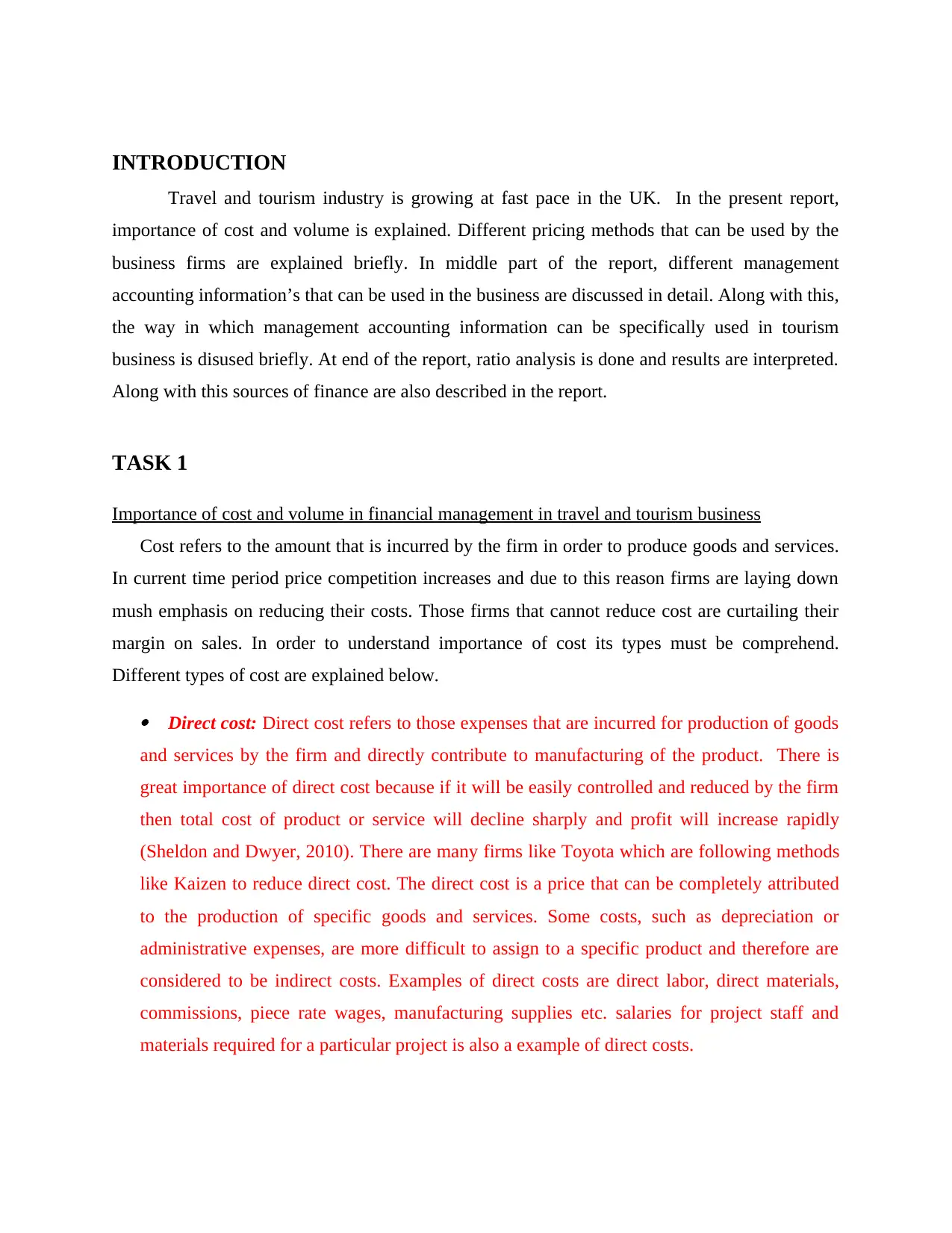
INTRODUCTION
Travel and tourism industry is growing at fast pace in the UK. In the present report,
importance of cost and volume is explained. Different pricing methods that can be used by the
business firms are explained briefly. In middle part of the report, different management
accounting information’s that can be used in the business are discussed in detail. Along with this,
the way in which management accounting information can be specifically used in tourism
business is disused briefly. At end of the report, ratio analysis is done and results are interpreted.
Along with this sources of finance are also described in the report.
TASK 1
Importance of cost and volume in financial management in travel and tourism business
Cost refers to the amount that is incurred by the firm in order to produce goods and services.
In current time period price competition increases and due to this reason firms are laying down
mush emphasis on reducing their costs. Those firms that cannot reduce cost are curtailing their
margin on sales. In order to understand importance of cost its types must be comprehend.
Different types of cost are explained below.
Direct cost: Direct cost refers to those expenses that are incurred for production of goods
and services by the firm and directly contribute to manufacturing of the product. There is
great importance of direct cost because if it will be easily controlled and reduced by the firm
then total cost of product or service will decline sharply and profit will increase rapidly
(Sheldon and Dwyer, 2010). There are many firms like Toyota which are following methods
like Kaizen to reduce direct cost. The direct cost is a price that can be completely attributed
to the production of specific goods and services. Some costs, such as depreciation or
administrative expenses, are more difficult to assign to a specific product and therefore are
considered to be indirect costs. Examples of direct costs are direct labor, direct materials,
commissions, piece rate wages, manufacturing supplies etc. salaries for project staff and
materials required for a particular project is also a example of direct costs.
Travel and tourism industry is growing at fast pace in the UK. In the present report,
importance of cost and volume is explained. Different pricing methods that can be used by the
business firms are explained briefly. In middle part of the report, different management
accounting information’s that can be used in the business are discussed in detail. Along with this,
the way in which management accounting information can be specifically used in tourism
business is disused briefly. At end of the report, ratio analysis is done and results are interpreted.
Along with this sources of finance are also described in the report.
TASK 1
Importance of cost and volume in financial management in travel and tourism business
Cost refers to the amount that is incurred by the firm in order to produce goods and services.
In current time period price competition increases and due to this reason firms are laying down
mush emphasis on reducing their costs. Those firms that cannot reduce cost are curtailing their
margin on sales. In order to understand importance of cost its types must be comprehend.
Different types of cost are explained below.
Direct cost: Direct cost refers to those expenses that are incurred for production of goods
and services by the firm and directly contribute to manufacturing of the product. There is
great importance of direct cost because if it will be easily controlled and reduced by the firm
then total cost of product or service will decline sharply and profit will increase rapidly
(Sheldon and Dwyer, 2010). There are many firms like Toyota which are following methods
like Kaizen to reduce direct cost. The direct cost is a price that can be completely attributed
to the production of specific goods and services. Some costs, such as depreciation or
administrative expenses, are more difficult to assign to a specific product and therefore are
considered to be indirect costs. Examples of direct costs are direct labor, direct materials,
commissions, piece rate wages, manufacturing supplies etc. salaries for project staff and
materials required for a particular project is also a example of direct costs.
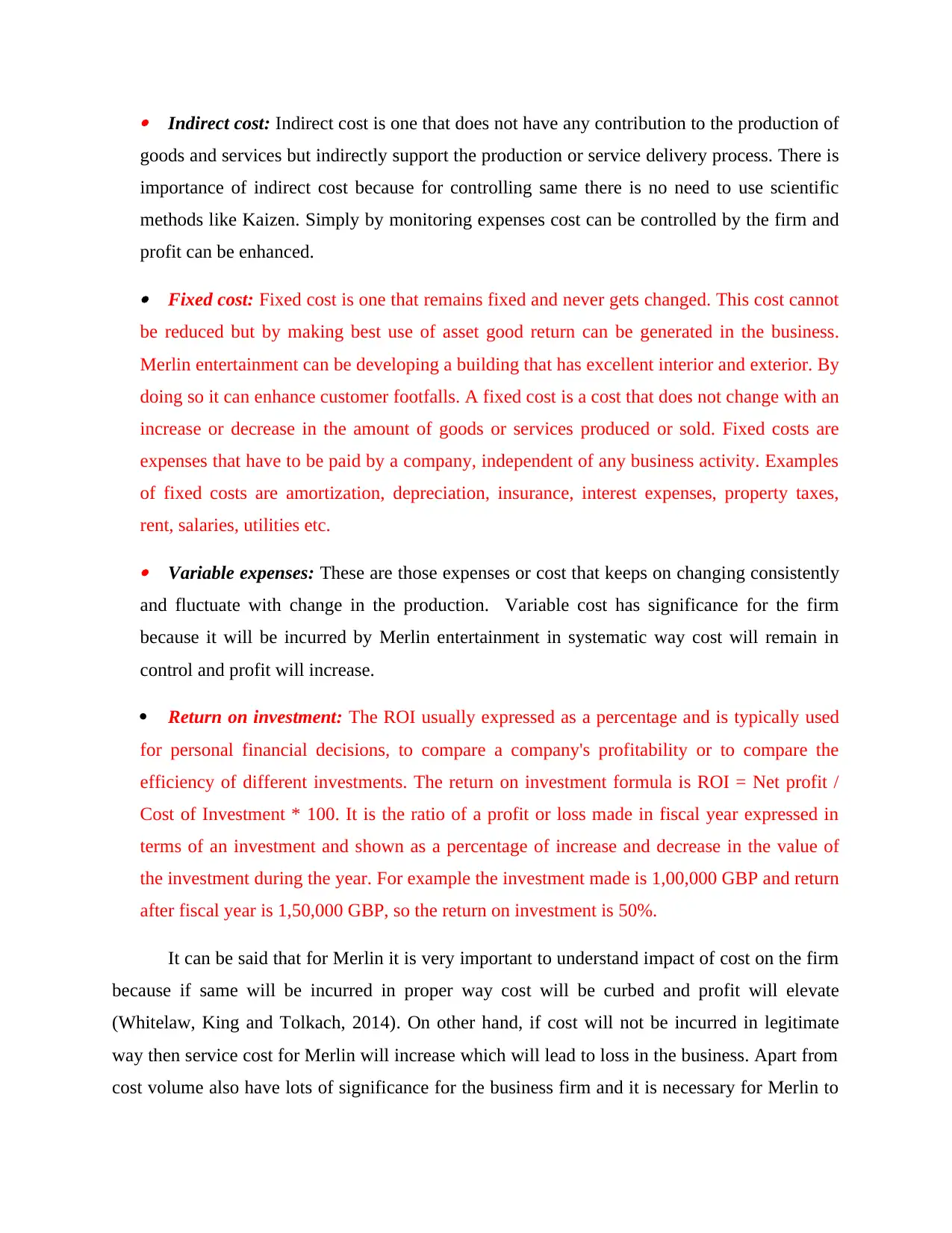
Indirect cost: Indirect cost is one that does not have any contribution to the production of
goods and services but indirectly support the production or service delivery process. There is
importance of indirect cost because for controlling same there is no need to use scientific
methods like Kaizen. Simply by monitoring expenses cost can be controlled by the firm and
profit can be enhanced.
Fixed cost: Fixed cost is one that remains fixed and never gets changed. This cost cannot
be reduced but by making best use of asset good return can be generated in the business.
Merlin entertainment can be developing a building that has excellent interior and exterior. By
doing so it can enhance customer footfalls. A fixed cost is a cost that does not change with an
increase or decrease in the amount of goods or services produced or sold. Fixed costs are
expenses that have to be paid by a company, independent of any business activity. Examples
of fixed costs are amortization, depreciation, insurance, interest expenses, property taxes,
rent, salaries, utilities etc.
Variable expenses: These are those expenses or cost that keeps on changing consistently
and fluctuate with change in the production. Variable cost has significance for the firm
because it will be incurred by Merlin entertainment in systematic way cost will remain in
control and profit will increase.
Return on investment: The ROI usually expressed as a percentage and is typically used
for personal financial decisions, to compare a company's profitability or to compare the
efficiency of different investments. The return on investment formula is ROI = Net profit /
Cost of Investment * 100. It is the ratio of a profit or loss made in fiscal year expressed in
terms of an investment and shown as a percentage of increase and decrease in the value of
the investment during the year. For example the investment made is 1,00,000 GBP and return
after fiscal year is 1,50,000 GBP, so the return on investment is 50%.
It can be said that for Merlin it is very important to understand impact of cost on the firm
because if same will be incurred in proper way cost will be curbed and profit will elevate
(Whitelaw, King and Tolkach, 2014). On other hand, if cost will not be incurred in legitimate
way then service cost for Merlin will increase which will lead to loss in the business. Apart from
cost volume also have lots of significance for the business firm and it is necessary for Merlin to
goods and services but indirectly support the production or service delivery process. There is
importance of indirect cost because for controlling same there is no need to use scientific
methods like Kaizen. Simply by monitoring expenses cost can be controlled by the firm and
profit can be enhanced.
Fixed cost: Fixed cost is one that remains fixed and never gets changed. This cost cannot
be reduced but by making best use of asset good return can be generated in the business.
Merlin entertainment can be developing a building that has excellent interior and exterior. By
doing so it can enhance customer footfalls. A fixed cost is a cost that does not change with an
increase or decrease in the amount of goods or services produced or sold. Fixed costs are
expenses that have to be paid by a company, independent of any business activity. Examples
of fixed costs are amortization, depreciation, insurance, interest expenses, property taxes,
rent, salaries, utilities etc.
Variable expenses: These are those expenses or cost that keeps on changing consistently
and fluctuate with change in the production. Variable cost has significance for the firm
because it will be incurred by Merlin entertainment in systematic way cost will remain in
control and profit will increase.
Return on investment: The ROI usually expressed as a percentage and is typically used
for personal financial decisions, to compare a company's profitability or to compare the
efficiency of different investments. The return on investment formula is ROI = Net profit /
Cost of Investment * 100. It is the ratio of a profit or loss made in fiscal year expressed in
terms of an investment and shown as a percentage of increase and decrease in the value of
the investment during the year. For example the investment made is 1,00,000 GBP and return
after fiscal year is 1,50,000 GBP, so the return on investment is 50%.
It can be said that for Merlin it is very important to understand impact of cost on the firm
because if same will be incurred in proper way cost will be curbed and profit will elevate
(Whitelaw, King and Tolkach, 2014). On other hand, if cost will not be incurred in legitimate
way then service cost for Merlin will increase which will lead to loss in the business. Apart from
cost volume also have lots of significance for the business firm and it is necessary for Merlin to
Secure Best Marks with AI Grader
Need help grading? Try our AI Grader for instant feedback on your assignments.
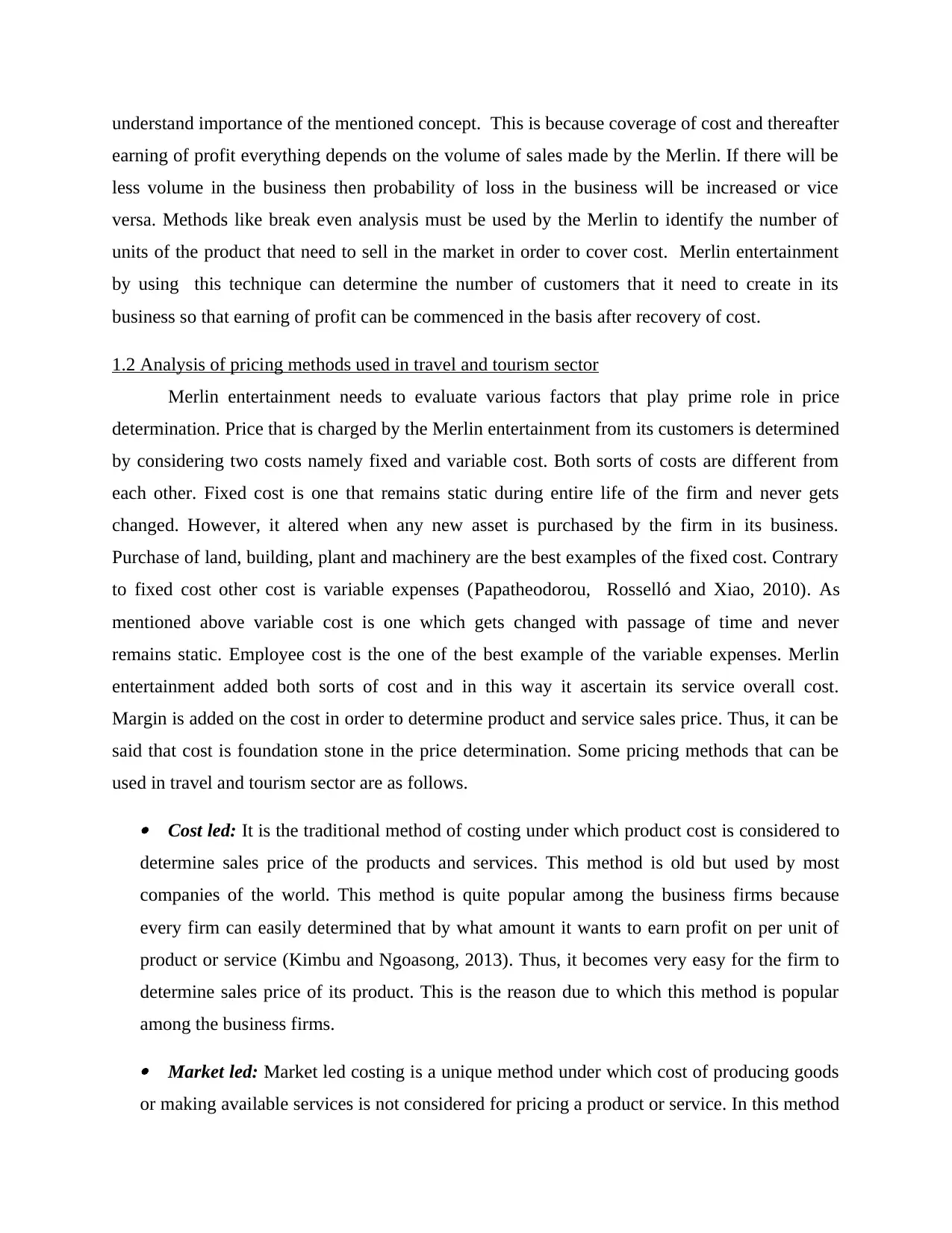
understand importance of the mentioned concept. This is because coverage of cost and thereafter
earning of profit everything depends on the volume of sales made by the Merlin. If there will be
less volume in the business then probability of loss in the business will be increased or vice
versa. Methods like break even analysis must be used by the Merlin to identify the number of
units of the product that need to sell in the market in order to cover cost. Merlin entertainment
by using this technique can determine the number of customers that it need to create in its
business so that earning of profit can be commenced in the basis after recovery of cost.
1.2 Analysis of pricing methods used in travel and tourism sector
Merlin entertainment needs to evaluate various factors that play prime role in price
determination. Price that is charged by the Merlin entertainment from its customers is determined
by considering two costs namely fixed and variable cost. Both sorts of costs are different from
each other. Fixed cost is one that remains static during entire life of the firm and never gets
changed. However, it altered when any new asset is purchased by the firm in its business.
Purchase of land, building, plant and machinery are the best examples of the fixed cost. Contrary
to fixed cost other cost is variable expenses (Papatheodorou, Rosselló and Xiao, 2010). As
mentioned above variable cost is one which gets changed with passage of time and never
remains static. Employee cost is the one of the best example of the variable expenses. Merlin
entertainment added both sorts of cost and in this way it ascertain its service overall cost.
Margin is added on the cost in order to determine product and service sales price. Thus, it can be
said that cost is foundation stone in the price determination. Some pricing methods that can be
used in travel and tourism sector are as follows.
Cost led: It is the traditional method of costing under which product cost is considered to
determine sales price of the products and services. This method is old but used by most
companies of the world. This method is quite popular among the business firms because
every firm can easily determined that by what amount it wants to earn profit on per unit of
product or service (Kimbu and Ngoasong, 2013). Thus, it becomes very easy for the firm to
determine sales price of its product. This is the reason due to which this method is popular
among the business firms.
Market led: Market led costing is a unique method under which cost of producing goods
or making available services is not considered for pricing a product or service. In this method
earning of profit everything depends on the volume of sales made by the Merlin. If there will be
less volume in the business then probability of loss in the business will be increased or vice
versa. Methods like break even analysis must be used by the Merlin to identify the number of
units of the product that need to sell in the market in order to cover cost. Merlin entertainment
by using this technique can determine the number of customers that it need to create in its
business so that earning of profit can be commenced in the basis after recovery of cost.
1.2 Analysis of pricing methods used in travel and tourism sector
Merlin entertainment needs to evaluate various factors that play prime role in price
determination. Price that is charged by the Merlin entertainment from its customers is determined
by considering two costs namely fixed and variable cost. Both sorts of costs are different from
each other. Fixed cost is one that remains static during entire life of the firm and never gets
changed. However, it altered when any new asset is purchased by the firm in its business.
Purchase of land, building, plant and machinery are the best examples of the fixed cost. Contrary
to fixed cost other cost is variable expenses (Papatheodorou, Rosselló and Xiao, 2010). As
mentioned above variable cost is one which gets changed with passage of time and never
remains static. Employee cost is the one of the best example of the variable expenses. Merlin
entertainment added both sorts of cost and in this way it ascertain its service overall cost.
Margin is added on the cost in order to determine product and service sales price. Thus, it can be
said that cost is foundation stone in the price determination. Some pricing methods that can be
used in travel and tourism sector are as follows.
Cost led: It is the traditional method of costing under which product cost is considered to
determine sales price of the products and services. This method is old but used by most
companies of the world. This method is quite popular among the business firms because
every firm can easily determined that by what amount it wants to earn profit on per unit of
product or service (Kimbu and Ngoasong, 2013). Thus, it becomes very easy for the firm to
determine sales price of its product. This is the reason due to which this method is popular
among the business firms.
Market led: Market led costing is a unique method under which cost of producing goods
or making available services is not considered for pricing a product or service. In this method
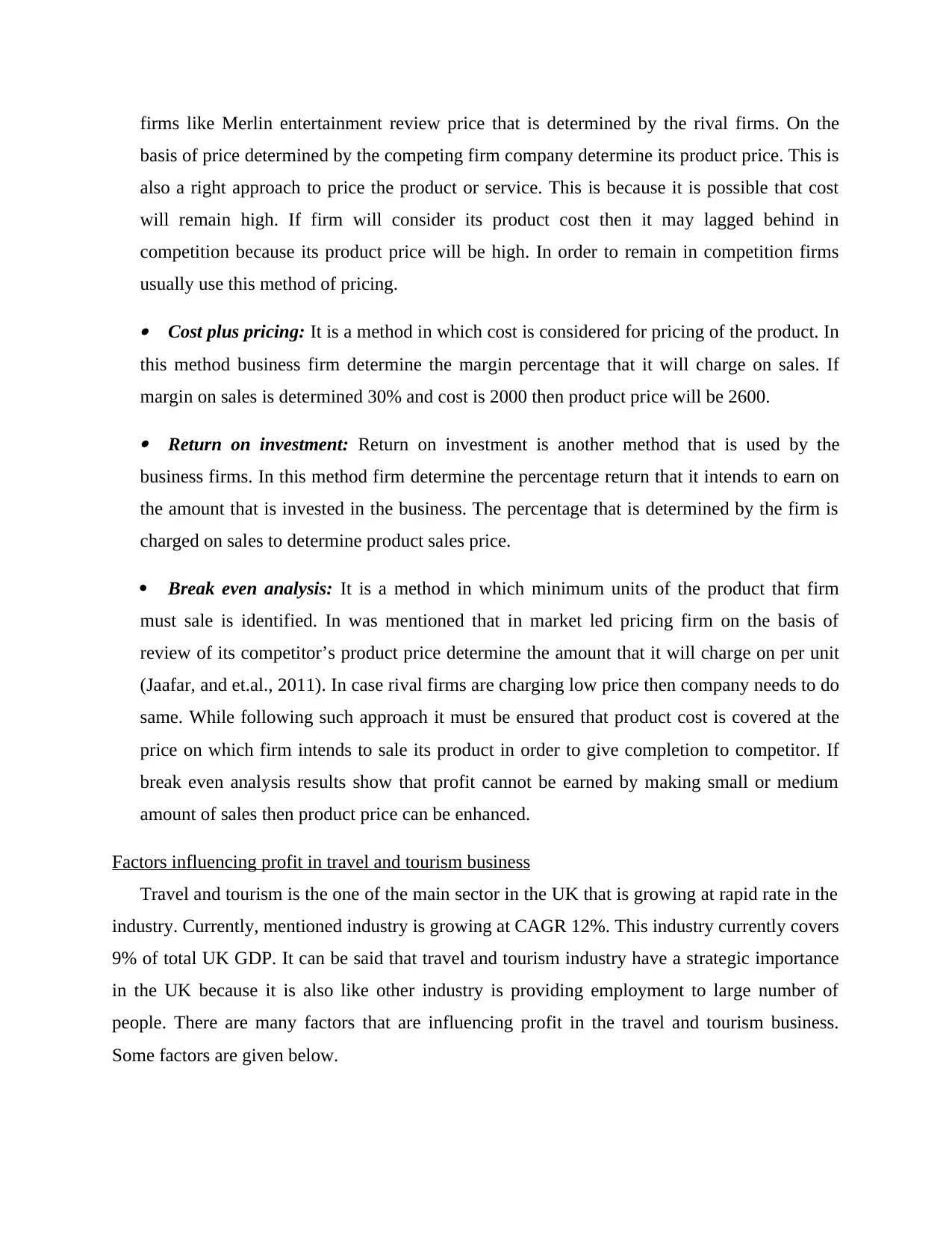
firms like Merlin entertainment review price that is determined by the rival firms. On the
basis of price determined by the competing firm company determine its product price. This is
also a right approach to price the product or service. This is because it is possible that cost
will remain high. If firm will consider its product cost then it may lagged behind in
competition because its product price will be high. In order to remain in competition firms
usually use this method of pricing.
Cost plus pricing: It is a method in which cost is considered for pricing of the product. In
this method business firm determine the margin percentage that it will charge on sales. If
margin on sales is determined 30% and cost is 2000 then product price will be 2600.
Return on investment: Return on investment is another method that is used by the
business firms. In this method firm determine the percentage return that it intends to earn on
the amount that is invested in the business. The percentage that is determined by the firm is
charged on sales to determine product sales price.
Break even analysis: It is a method in which minimum units of the product that firm
must sale is identified. In was mentioned that in market led pricing firm on the basis of
review of its competitor’s product price determine the amount that it will charge on per unit
(Jaafar, and et.al., 2011). In case rival firms are charging low price then company needs to do
same. While following such approach it must be ensured that product cost is covered at the
price on which firm intends to sale its product in order to give completion to competitor. If
break even analysis results show that profit cannot be earned by making small or medium
amount of sales then product price can be enhanced.
Factors influencing profit in travel and tourism business
Travel and tourism is the one of the main sector in the UK that is growing at rapid rate in the
industry. Currently, mentioned industry is growing at CAGR 12%. This industry currently covers
9% of total UK GDP. It can be said that travel and tourism industry have a strategic importance
in the UK because it is also like other industry is providing employment to large number of
people. There are many factors that are influencing profit in the travel and tourism business.
Some factors are given below.
basis of price determined by the competing firm company determine its product price. This is
also a right approach to price the product or service. This is because it is possible that cost
will remain high. If firm will consider its product cost then it may lagged behind in
competition because its product price will be high. In order to remain in competition firms
usually use this method of pricing.
Cost plus pricing: It is a method in which cost is considered for pricing of the product. In
this method business firm determine the margin percentage that it will charge on sales. If
margin on sales is determined 30% and cost is 2000 then product price will be 2600.
Return on investment: Return on investment is another method that is used by the
business firms. In this method firm determine the percentage return that it intends to earn on
the amount that is invested in the business. The percentage that is determined by the firm is
charged on sales to determine product sales price.
Break even analysis: It is a method in which minimum units of the product that firm
must sale is identified. In was mentioned that in market led pricing firm on the basis of
review of its competitor’s product price determine the amount that it will charge on per unit
(Jaafar, and et.al., 2011). In case rival firms are charging low price then company needs to do
same. While following such approach it must be ensured that product cost is covered at the
price on which firm intends to sale its product in order to give completion to competitor. If
break even analysis results show that profit cannot be earned by making small or medium
amount of sales then product price can be enhanced.
Factors influencing profit in travel and tourism business
Travel and tourism is the one of the main sector in the UK that is growing at rapid rate in the
industry. Currently, mentioned industry is growing at CAGR 12%. This industry currently covers
9% of total UK GDP. It can be said that travel and tourism industry have a strategic importance
in the UK because it is also like other industry is providing employment to large number of
people. There are many factors that are influencing profit in the travel and tourism business.
Some factors are given below.
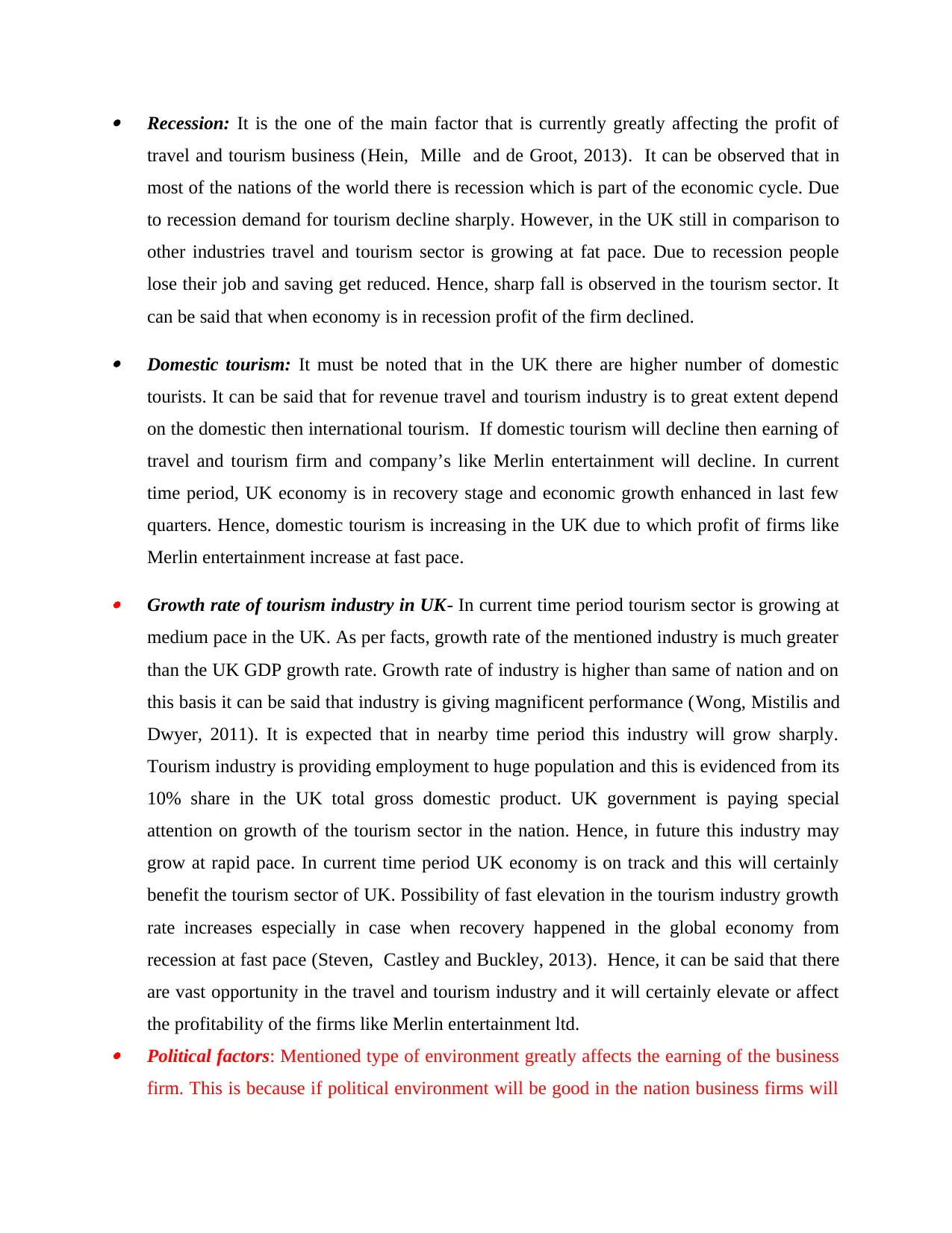
Recession: It is the one of the main factor that is currently greatly affecting the profit of
travel and tourism business (Hein, Mille and de Groot, 2013). It can be observed that in
most of the nations of the world there is recession which is part of the economic cycle. Due
to recession demand for tourism decline sharply. However, in the UK still in comparison to
other industries travel and tourism sector is growing at fat pace. Due to recession people
lose their job and saving get reduced. Hence, sharp fall is observed in the tourism sector. It
can be said that when economy is in recession profit of the firm declined.
Domestic tourism: It must be noted that in the UK there are higher number of domestic
tourists. It can be said that for revenue travel and tourism industry is to great extent depend
on the domestic then international tourism. If domestic tourism will decline then earning of
travel and tourism firm and company’s like Merlin entertainment will decline. In current
time period, UK economy is in recovery stage and economic growth enhanced in last few
quarters. Hence, domestic tourism is increasing in the UK due to which profit of firms like
Merlin entertainment increase at fast pace.
Growth rate of tourism industry in UK- In current time period tourism sector is growing at
medium pace in the UK. As per facts, growth rate of the mentioned industry is much greater
than the UK GDP growth rate. Growth rate of industry is higher than same of nation and on
this basis it can be said that industry is giving magnificent performance (Wong, Mistilis and
Dwyer, 2011). It is expected that in nearby time period this industry will grow sharply.
Tourism industry is providing employment to huge population and this is evidenced from its
10% share in the UK total gross domestic product. UK government is paying special
attention on growth of the tourism sector in the nation. Hence, in future this industry may
grow at rapid pace. In current time period UK economy is on track and this will certainly
benefit the tourism sector of UK. Possibility of fast elevation in the tourism industry growth
rate increases especially in case when recovery happened in the global economy from
recession at fast pace (Steven, Castley and Buckley, 2013). Hence, it can be said that there
are vast opportunity in the travel and tourism industry and it will certainly elevate or affect
the profitability of the firms like Merlin entertainment ltd. Political factors: Mentioned type of environment greatly affects the earning of the business
firm. This is because if political environment will be good in the nation business firms will
travel and tourism business (Hein, Mille and de Groot, 2013). It can be observed that in
most of the nations of the world there is recession which is part of the economic cycle. Due
to recession demand for tourism decline sharply. However, in the UK still in comparison to
other industries travel and tourism sector is growing at fat pace. Due to recession people
lose their job and saving get reduced. Hence, sharp fall is observed in the tourism sector. It
can be said that when economy is in recession profit of the firm declined.
Domestic tourism: It must be noted that in the UK there are higher number of domestic
tourists. It can be said that for revenue travel and tourism industry is to great extent depend
on the domestic then international tourism. If domestic tourism will decline then earning of
travel and tourism firm and company’s like Merlin entertainment will decline. In current
time period, UK economy is in recovery stage and economic growth enhanced in last few
quarters. Hence, domestic tourism is increasing in the UK due to which profit of firms like
Merlin entertainment increase at fast pace.
Growth rate of tourism industry in UK- In current time period tourism sector is growing at
medium pace in the UK. As per facts, growth rate of the mentioned industry is much greater
than the UK GDP growth rate. Growth rate of industry is higher than same of nation and on
this basis it can be said that industry is giving magnificent performance (Wong, Mistilis and
Dwyer, 2011). It is expected that in nearby time period this industry will grow sharply.
Tourism industry is providing employment to huge population and this is evidenced from its
10% share in the UK total gross domestic product. UK government is paying special
attention on growth of the tourism sector in the nation. Hence, in future this industry may
grow at rapid pace. In current time period UK economy is on track and this will certainly
benefit the tourism sector of UK. Possibility of fast elevation in the tourism industry growth
rate increases especially in case when recovery happened in the global economy from
recession at fast pace (Steven, Castley and Buckley, 2013). Hence, it can be said that there
are vast opportunity in the travel and tourism industry and it will certainly elevate or affect
the profitability of the firms like Merlin entertainment ltd. Political factors: Mentioned type of environment greatly affects the earning of the business
firm. This is because if political environment will be good in the nation business firms will
Paraphrase This Document
Need a fresh take? Get an instant paraphrase of this document with our AI Paraphraser
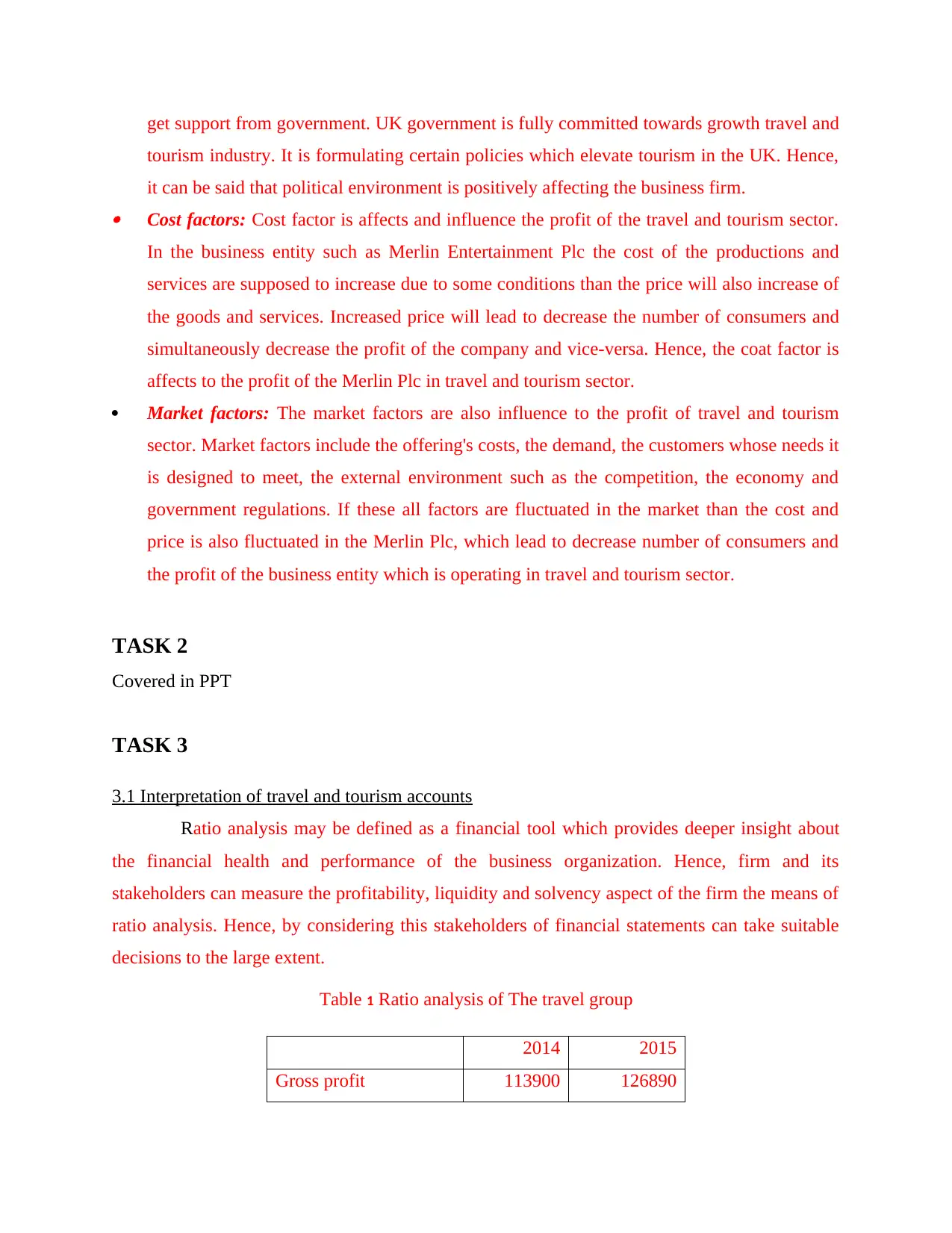
get support from government. UK government is fully committed towards growth travel and
tourism industry. It is formulating certain policies which elevate tourism in the UK. Hence,
it can be said that political environment is positively affecting the business firm. Cost factors: Cost factor is affects and influence the profit of the travel and tourism sector.
In the business entity such as Merlin Entertainment Plc the cost of the productions and
services are supposed to increase due to some conditions than the price will also increase of
the goods and services. Increased price will lead to decrease the number of consumers and
simultaneously decrease the profit of the company and vice-versa. Hence, the coat factor is
affects to the profit of the Merlin Plc in travel and tourism sector.
Market factors: The market factors are also influence to the profit of travel and tourism
sector. Market factors include the offering's costs, the demand, the customers whose needs it
is designed to meet, the external environment such as the competition, the economy and
government regulations. If these all factors are fluctuated in the market than the cost and
price is also fluctuated in the Merlin Plc, which lead to decrease number of consumers and
the profit of the business entity which is operating in travel and tourism sector.
TASK 2
Covered in PPT
TASK 3
3.1 Interpretation of travel and tourism accounts
Ratio analysis may be defined as a financial tool which provides deeper insight about
the financial health and performance of the business organization. Hence, firm and its
stakeholders can measure the profitability, liquidity and solvency aspect of the firm the means of
ratio analysis. Hence, by considering this stakeholders of financial statements can take suitable
decisions to the large extent.
Table 1 Ratio analysis of The travel group
2014 2015
Gross profit 113900 126890
tourism industry. It is formulating certain policies which elevate tourism in the UK. Hence,
it can be said that political environment is positively affecting the business firm. Cost factors: Cost factor is affects and influence the profit of the travel and tourism sector.
In the business entity such as Merlin Entertainment Plc the cost of the productions and
services are supposed to increase due to some conditions than the price will also increase of
the goods and services. Increased price will lead to decrease the number of consumers and
simultaneously decrease the profit of the company and vice-versa. Hence, the coat factor is
affects to the profit of the Merlin Plc in travel and tourism sector.
Market factors: The market factors are also influence to the profit of travel and tourism
sector. Market factors include the offering's costs, the demand, the customers whose needs it
is designed to meet, the external environment such as the competition, the economy and
government regulations. If these all factors are fluctuated in the market than the cost and
price is also fluctuated in the Merlin Plc, which lead to decrease number of consumers and
the profit of the business entity which is operating in travel and tourism sector.
TASK 2
Covered in PPT
TASK 3
3.1 Interpretation of travel and tourism accounts
Ratio analysis may be defined as a financial tool which provides deeper insight about
the financial health and performance of the business organization. Hence, firm and its
stakeholders can measure the profitability, liquidity and solvency aspect of the firm the means of
ratio analysis. Hence, by considering this stakeholders of financial statements can take suitable
decisions to the large extent.
Table 1 Ratio analysis of The travel group
2014 2015
Gross profit 113900 126890
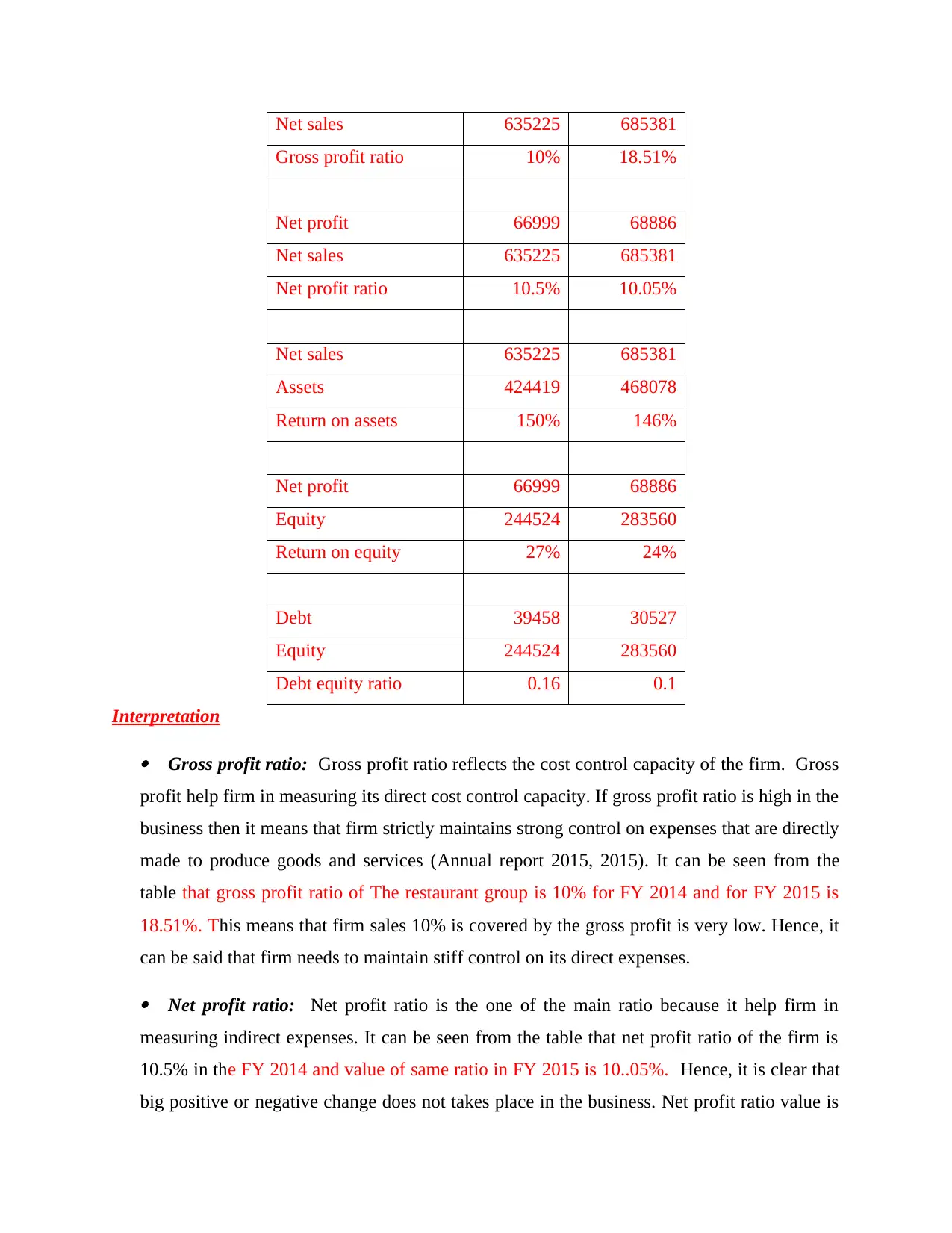
Net sales 635225 685381
Gross profit ratio 10% 18.51%
Net profit 66999 68886
Net sales 635225 685381
Net profit ratio 10.5% 10.05%
Net sales 635225 685381
Assets 424419 468078
Return on assets 150% 146%
Net profit 66999 68886
Equity 244524 283560
Return on equity 27% 24%
Debt 39458 30527
Equity 244524 283560
Debt equity ratio 0.16 0.1
Interpretation
Gross profit ratio: Gross profit ratio reflects the cost control capacity of the firm. Gross
profit help firm in measuring its direct cost control capacity. If gross profit ratio is high in the
business then it means that firm strictly maintains strong control on expenses that are directly
made to produce goods and services (Annual report 2015, 2015). It can be seen from the
table that gross profit ratio of The restaurant group is 10% for FY 2014 and for FY 2015 is
18.51%. This means that firm sales 10% is covered by the gross profit is very low. Hence, it
can be said that firm needs to maintain stiff control on its direct expenses.
Net profit ratio: Net profit ratio is the one of the main ratio because it help firm in
measuring indirect expenses. It can be seen from the table that net profit ratio of the firm is
10.5% in the FY 2014 and value of same ratio in FY 2015 is 10..05%. Hence, it is clear that
big positive or negative change does not takes place in the business. Net profit ratio value is
Gross profit ratio 10% 18.51%
Net profit 66999 68886
Net sales 635225 685381
Net profit ratio 10.5% 10.05%
Net sales 635225 685381
Assets 424419 468078
Return on assets 150% 146%
Net profit 66999 68886
Equity 244524 283560
Return on equity 27% 24%
Debt 39458 30527
Equity 244524 283560
Debt equity ratio 0.16 0.1
Interpretation
Gross profit ratio: Gross profit ratio reflects the cost control capacity of the firm. Gross
profit help firm in measuring its direct cost control capacity. If gross profit ratio is high in the
business then it means that firm strictly maintains strong control on expenses that are directly
made to produce goods and services (Annual report 2015, 2015). It can be seen from the
table that gross profit ratio of The restaurant group is 10% for FY 2014 and for FY 2015 is
18.51%. This means that firm sales 10% is covered by the gross profit is very low. Hence, it
can be said that firm needs to maintain stiff control on its direct expenses.
Net profit ratio: Net profit ratio is the one of the main ratio because it help firm in
measuring indirect expenses. It can be seen from the table that net profit ratio of the firm is
10.5% in the FY 2014 and value of same ratio in FY 2015 is 10..05%. Hence, it is clear that
big positive or negative change does not takes place in the business. Net profit ratio value is
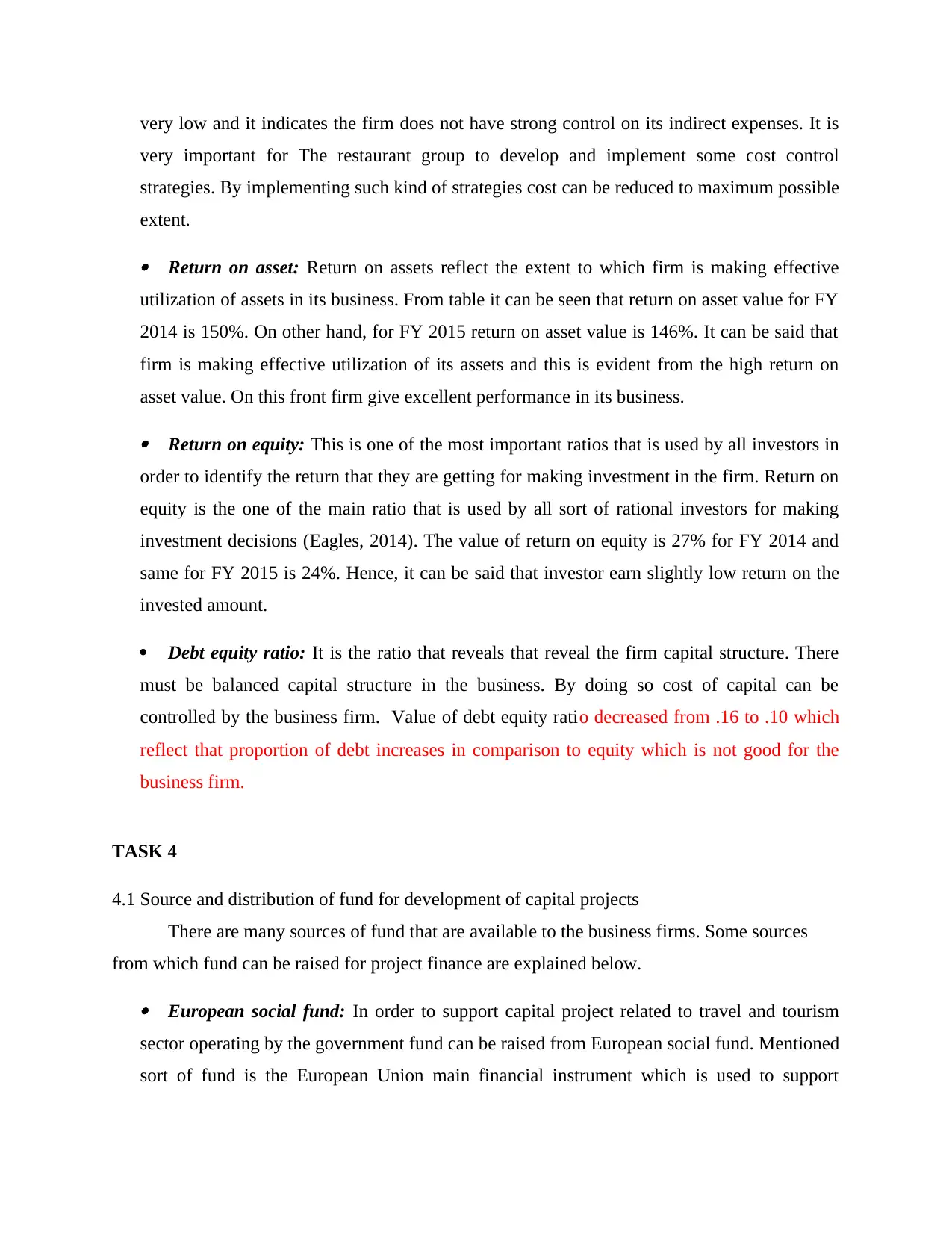
very low and it indicates the firm does not have strong control on its indirect expenses. It is
very important for The restaurant group to develop and implement some cost control
strategies. By implementing such kind of strategies cost can be reduced to maximum possible
extent.
Return on asset: Return on assets reflect the extent to which firm is making effective
utilization of assets in its business. From table it can be seen that return on asset value for FY
2014 is 150%. On other hand, for FY 2015 return on asset value is 146%. It can be said that
firm is making effective utilization of its assets and this is evident from the high return on
asset value. On this front firm give excellent performance in its business.
Return on equity: This is one of the most important ratios that is used by all investors in
order to identify the return that they are getting for making investment in the firm. Return on
equity is the one of the main ratio that is used by all sort of rational investors for making
investment decisions (Eagles, 2014). The value of return on equity is 27% for FY 2014 and
same for FY 2015 is 24%. Hence, it can be said that investor earn slightly low return on the
invested amount.
Debt equity ratio: It is the ratio that reveals that reveal the firm capital structure. There
must be balanced capital structure in the business. By doing so cost of capital can be
controlled by the business firm. Value of debt equity ratio decreased from .16 to .10 which
reflect that proportion of debt increases in comparison to equity which is not good for the
business firm.
TASK 4
4.1 Source and distribution of fund for development of capital projects
There are many sources of fund that are available to the business firms. Some sources
from which fund can be raised for project finance are explained below.
European social fund: In order to support capital project related to travel and tourism
sector operating by the government fund can be raised from European social fund. Mentioned
sort of fund is the European Union main financial instrument which is used to support
very important for The restaurant group to develop and implement some cost control
strategies. By implementing such kind of strategies cost can be reduced to maximum possible
extent.
Return on asset: Return on assets reflect the extent to which firm is making effective
utilization of assets in its business. From table it can be seen that return on asset value for FY
2014 is 150%. On other hand, for FY 2015 return on asset value is 146%. It can be said that
firm is making effective utilization of its assets and this is evident from the high return on
asset value. On this front firm give excellent performance in its business.
Return on equity: This is one of the most important ratios that is used by all investors in
order to identify the return that they are getting for making investment in the firm. Return on
equity is the one of the main ratio that is used by all sort of rational investors for making
investment decisions (Eagles, 2014). The value of return on equity is 27% for FY 2014 and
same for FY 2015 is 24%. Hence, it can be said that investor earn slightly low return on the
invested amount.
Debt equity ratio: It is the ratio that reveals that reveal the firm capital structure. There
must be balanced capital structure in the business. By doing so cost of capital can be
controlled by the business firm. Value of debt equity ratio decreased from .16 to .10 which
reflect that proportion of debt increases in comparison to equity which is not good for the
business firm.
TASK 4
4.1 Source and distribution of fund for development of capital projects
There are many sources of fund that are available to the business firms. Some sources
from which fund can be raised for project finance are explained below.
European social fund: In order to support capital project related to travel and tourism
sector operating by the government fund can be raised from European social fund. Mentioned
sort of fund is the European Union main financial instrument which is used to support
Secure Best Marks with AI Grader
Need help grading? Try our AI Grader for instant feedback on your assignments.
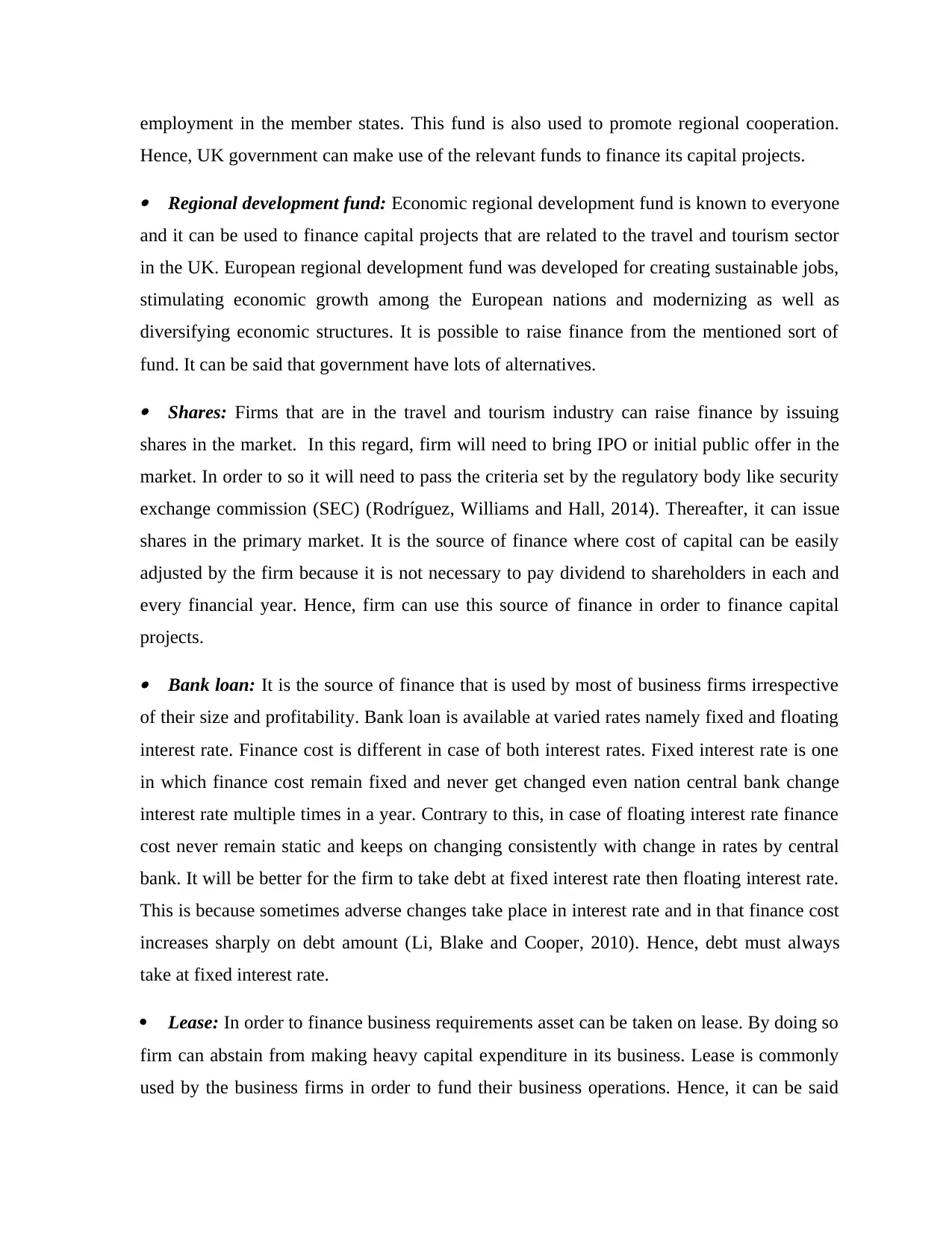
employment in the member states. This fund is also used to promote regional cooperation.
Hence, UK government can make use of the relevant funds to finance its capital projects.
Regional development fund: Economic regional development fund is known to everyone
and it can be used to finance capital projects that are related to the travel and tourism sector
in the UK. European regional development fund was developed for creating sustainable jobs,
stimulating economic growth among the European nations and modernizing as well as
diversifying economic structures. It is possible to raise finance from the mentioned sort of
fund. It can be said that government have lots of alternatives.
Shares: Firms that are in the travel and tourism industry can raise finance by issuing
shares in the market. In this regard, firm will need to bring IPO or initial public offer in the
market. In order to so it will need to pass the criteria set by the regulatory body like security
exchange commission (SEC) (Rodríguez, Williams and Hall, 2014). Thereafter, it can issue
shares in the primary market. It is the source of finance where cost of capital can be easily
adjusted by the firm because it is not necessary to pay dividend to shareholders in each and
every financial year. Hence, firm can use this source of finance in order to finance capital
projects.
Bank loan: It is the source of finance that is used by most of business firms irrespective
of their size and profitability. Bank loan is available at varied rates namely fixed and floating
interest rate. Finance cost is different in case of both interest rates. Fixed interest rate is one
in which finance cost remain fixed and never get changed even nation central bank change
interest rate multiple times in a year. Contrary to this, in case of floating interest rate finance
cost never remain static and keeps on changing consistently with change in rates by central
bank. It will be better for the firm to take debt at fixed interest rate then floating interest rate.
This is because sometimes adverse changes take place in interest rate and in that finance cost
increases sharply on debt amount (Li, Blake and Cooper, 2010). Hence, debt must always
take at fixed interest rate.
Lease: In order to finance business requirements asset can be taken on lease. By doing so
firm can abstain from making heavy capital expenditure in its business. Lease is commonly
used by the business firms in order to fund their business operations. Hence, it can be said
Hence, UK government can make use of the relevant funds to finance its capital projects.
Regional development fund: Economic regional development fund is known to everyone
and it can be used to finance capital projects that are related to the travel and tourism sector
in the UK. European regional development fund was developed for creating sustainable jobs,
stimulating economic growth among the European nations and modernizing as well as
diversifying economic structures. It is possible to raise finance from the mentioned sort of
fund. It can be said that government have lots of alternatives.
Shares: Firms that are in the travel and tourism industry can raise finance by issuing
shares in the market. In this regard, firm will need to bring IPO or initial public offer in the
market. In order to so it will need to pass the criteria set by the regulatory body like security
exchange commission (SEC) (Rodríguez, Williams and Hall, 2014). Thereafter, it can issue
shares in the primary market. It is the source of finance where cost of capital can be easily
adjusted by the firm because it is not necessary to pay dividend to shareholders in each and
every financial year. Hence, firm can use this source of finance in order to finance capital
projects.
Bank loan: It is the source of finance that is used by most of business firms irrespective
of their size and profitability. Bank loan is available at varied rates namely fixed and floating
interest rate. Finance cost is different in case of both interest rates. Fixed interest rate is one
in which finance cost remain fixed and never get changed even nation central bank change
interest rate multiple times in a year. Contrary to this, in case of floating interest rate finance
cost never remain static and keeps on changing consistently with change in rates by central
bank. It will be better for the firm to take debt at fixed interest rate then floating interest rate.
This is because sometimes adverse changes take place in interest rate and in that finance cost
increases sharply on debt amount (Li, Blake and Cooper, 2010). Hence, debt must always
take at fixed interest rate.
Lease: In order to finance business requirements asset can be taken on lease. By doing so
firm can abstain from making heavy capital expenditure in its business. Lease is commonly
used by the business firms in order to fund their business operations. Hence, it can be said
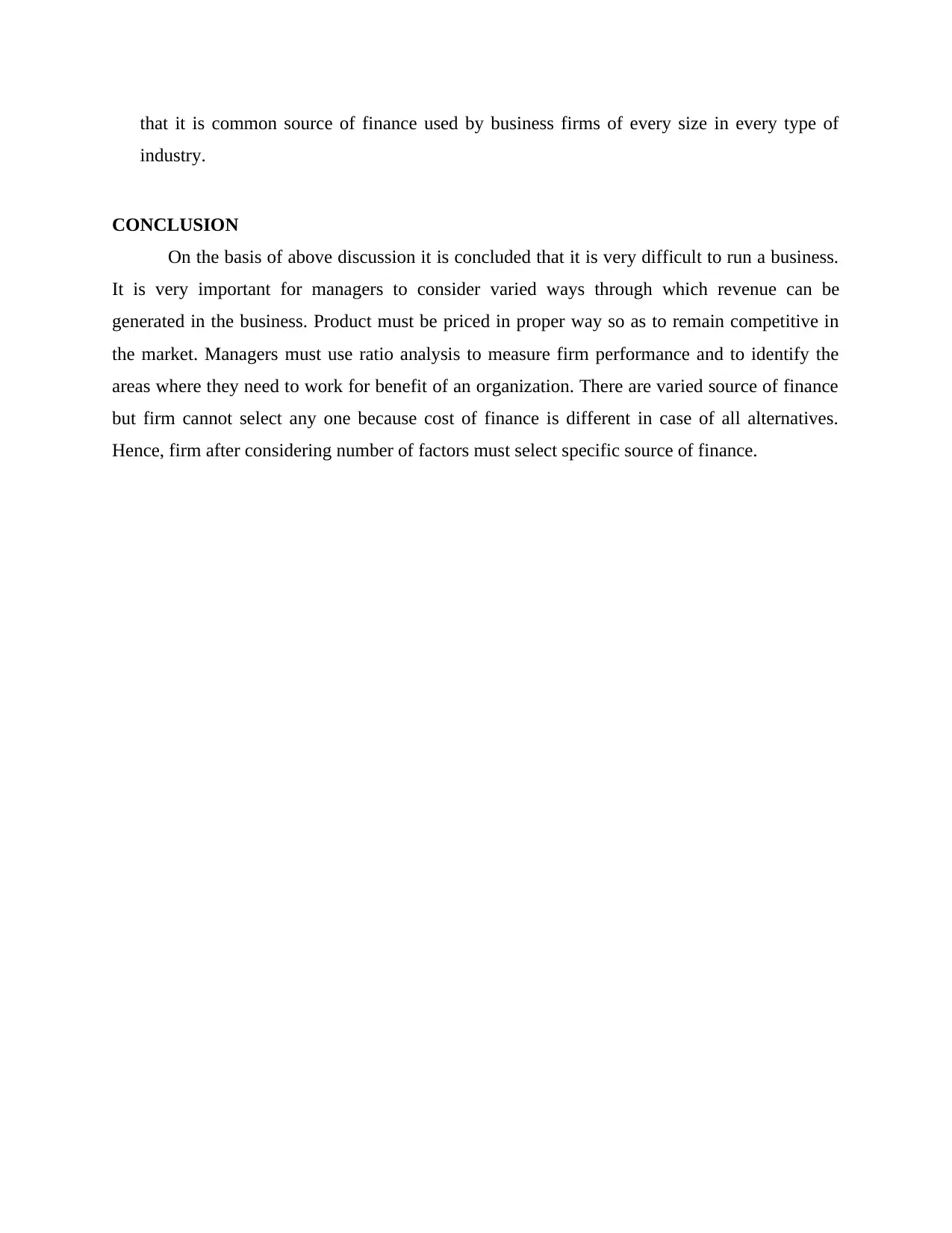
that it is common source of finance used by business firms of every size in every type of
industry.
CONCLUSION
On the basis of above discussion it is concluded that it is very difficult to run a business.
It is very important for managers to consider varied ways through which revenue can be
generated in the business. Product must be priced in proper way so as to remain competitive in
the market. Managers must use ratio analysis to measure firm performance and to identify the
areas where they need to work for benefit of an organization. There are varied source of finance
but firm cannot select any one because cost of finance is different in case of all alternatives.
Hence, firm after considering number of factors must select specific source of finance.
industry.
CONCLUSION
On the basis of above discussion it is concluded that it is very difficult to run a business.
It is very important for managers to consider varied ways through which revenue can be
generated in the business. Product must be priced in proper way so as to remain competitive in
the market. Managers must use ratio analysis to measure firm performance and to identify the
areas where they need to work for benefit of an organization. There are varied source of finance
but firm cannot select any one because cost of finance is different in case of all alternatives.
Hence, firm after considering number of factors must select specific source of finance.
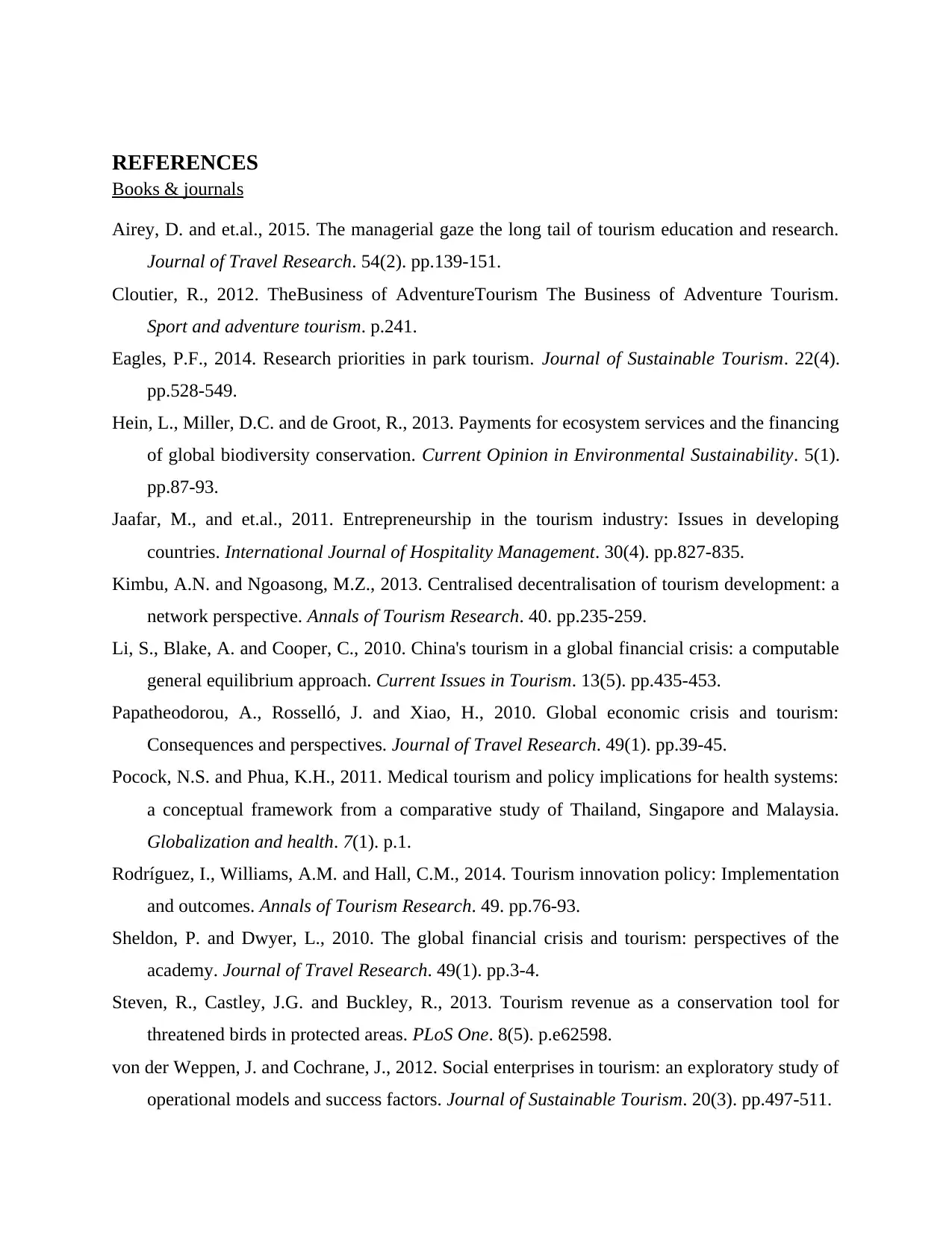
REFERENCES
Books & journals
Airey, D. and et.al., 2015. The managerial gaze the long tail of tourism education and research.
Journal of Travel Research. 54(2). pp.139-151.
Cloutier, R., 2012. TheBusiness of AdventureTourism The Business of Adventure Tourism.
Sport and adventure tourism. p.241.
Eagles, P.F., 2014. Research priorities in park tourism. Journal of Sustainable Tourism. 22(4).
pp.528-549.
Hein, L., Miller, D.C. and de Groot, R., 2013. Payments for ecosystem services and the financing
of global biodiversity conservation. Current Opinion in Environmental Sustainability. 5(1).
pp.87-93.
Jaafar, M., and et.al., 2011. Entrepreneurship in the tourism industry: Issues in developing
countries. International Journal of Hospitality Management. 30(4). pp.827-835.
Kimbu, A.N. and Ngoasong, M.Z., 2013. Centralised decentralisation of tourism development: a
network perspective. Annals of Tourism Research. 40. pp.235-259.
Li, S., Blake, A. and Cooper, C., 2010. China's tourism in a global financial crisis: a computable
general equilibrium approach. Current Issues in Tourism. 13(5). pp.435-453.
Papatheodorou, A., Rosselló, J. and Xiao, H., 2010. Global economic crisis and tourism:
Consequences and perspectives. Journal of Travel Research. 49(1). pp.39-45.
Pocock, N.S. and Phua, K.H., 2011. Medical tourism and policy implications for health systems:
a conceptual framework from a comparative study of Thailand, Singapore and Malaysia.
Globalization and health. 7(1). p.1.
Rodríguez, I., Williams, A.M. and Hall, C.M., 2014. Tourism innovation policy: Implementation
and outcomes. Annals of Tourism Research. 49. pp.76-93.
Sheldon, P. and Dwyer, L., 2010. The global financial crisis and tourism: perspectives of the
academy. Journal of Travel Research. 49(1). pp.3-4.
Steven, R., Castley, J.G. and Buckley, R., 2013. Tourism revenue as a conservation tool for
threatened birds in protected areas. PLoS One. 8(5). p.e62598.
von der Weppen, J. and Cochrane, J., 2012. Social enterprises in tourism: an exploratory study of
operational models and success factors. Journal of Sustainable Tourism. 20(3). pp.497-511.
Books & journals
Airey, D. and et.al., 2015. The managerial gaze the long tail of tourism education and research.
Journal of Travel Research. 54(2). pp.139-151.
Cloutier, R., 2012. TheBusiness of AdventureTourism The Business of Adventure Tourism.
Sport and adventure tourism. p.241.
Eagles, P.F., 2014. Research priorities in park tourism. Journal of Sustainable Tourism. 22(4).
pp.528-549.
Hein, L., Miller, D.C. and de Groot, R., 2013. Payments for ecosystem services and the financing
of global biodiversity conservation. Current Opinion in Environmental Sustainability. 5(1).
pp.87-93.
Jaafar, M., and et.al., 2011. Entrepreneurship in the tourism industry: Issues in developing
countries. International Journal of Hospitality Management. 30(4). pp.827-835.
Kimbu, A.N. and Ngoasong, M.Z., 2013. Centralised decentralisation of tourism development: a
network perspective. Annals of Tourism Research. 40. pp.235-259.
Li, S., Blake, A. and Cooper, C., 2010. China's tourism in a global financial crisis: a computable
general equilibrium approach. Current Issues in Tourism. 13(5). pp.435-453.
Papatheodorou, A., Rosselló, J. and Xiao, H., 2010. Global economic crisis and tourism:
Consequences and perspectives. Journal of Travel Research. 49(1). pp.39-45.
Pocock, N.S. and Phua, K.H., 2011. Medical tourism and policy implications for health systems:
a conceptual framework from a comparative study of Thailand, Singapore and Malaysia.
Globalization and health. 7(1). p.1.
Rodríguez, I., Williams, A.M. and Hall, C.M., 2014. Tourism innovation policy: Implementation
and outcomes. Annals of Tourism Research. 49. pp.76-93.
Sheldon, P. and Dwyer, L., 2010. The global financial crisis and tourism: perspectives of the
academy. Journal of Travel Research. 49(1). pp.3-4.
Steven, R., Castley, J.G. and Buckley, R., 2013. Tourism revenue as a conservation tool for
threatened birds in protected areas. PLoS One. 8(5). p.e62598.
von der Weppen, J. and Cochrane, J., 2012. Social enterprises in tourism: an exploratory study of
operational models and success factors. Journal of Sustainable Tourism. 20(3). pp.497-511.
Paraphrase This Document
Need a fresh take? Get an instant paraphrase of this document with our AI Paraphraser
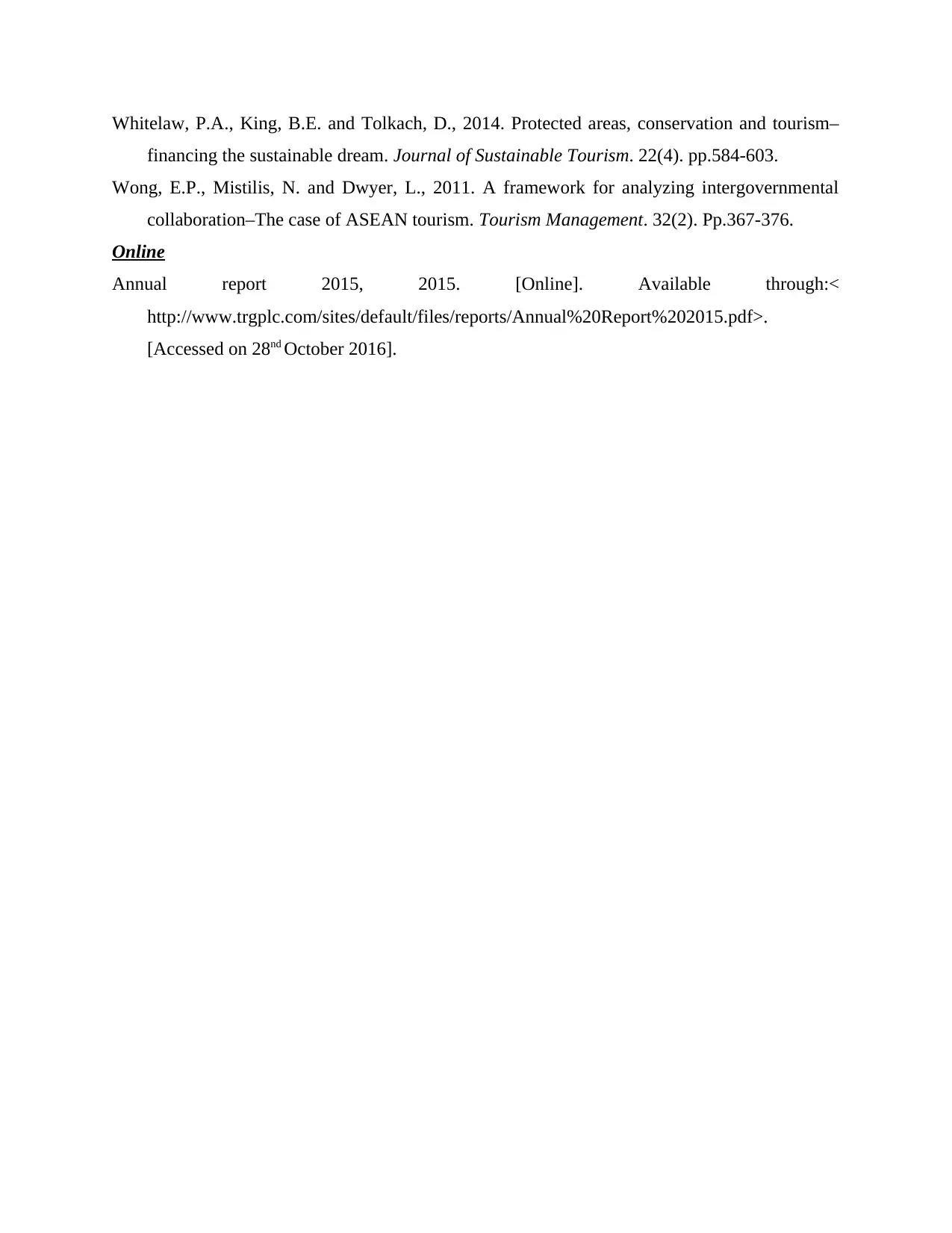
Whitelaw, P.A., King, B.E. and Tolkach, D., 2014. Protected areas, conservation and tourism–
financing the sustainable dream. Journal of Sustainable Tourism. 22(4). pp.584-603.
Wong, E.P., Mistilis, N. and Dwyer, L., 2011. A framework for analyzing intergovernmental
collaboration–The case of ASEAN tourism. Tourism Management. 32(2). Pp.367-376.
Online
Annual report 2015, 2015. [Online]. Available through:<
http://www.trgplc.com/sites/default/files/reports/Annual%20Report%202015.pdf>.
[Accessed on 28nd October 2016].
financing the sustainable dream. Journal of Sustainable Tourism. 22(4). pp.584-603.
Wong, E.P., Mistilis, N. and Dwyer, L., 2011. A framework for analyzing intergovernmental
collaboration–The case of ASEAN tourism. Tourism Management. 32(2). Pp.367-376.
Online
Annual report 2015, 2015. [Online]. Available through:<
http://www.trgplc.com/sites/default/files/reports/Annual%20Report%202015.pdf>.
[Accessed on 28nd October 2016].
1 out of 14
Related Documents
Your All-in-One AI-Powered Toolkit for Academic Success.
+13062052269
info@desklib.com
Available 24*7 on WhatsApp / Email
![[object Object]](/_next/static/media/star-bottom.7253800d.svg)
Unlock your academic potential
© 2024 | Zucol Services PVT LTD | All rights reserved.





